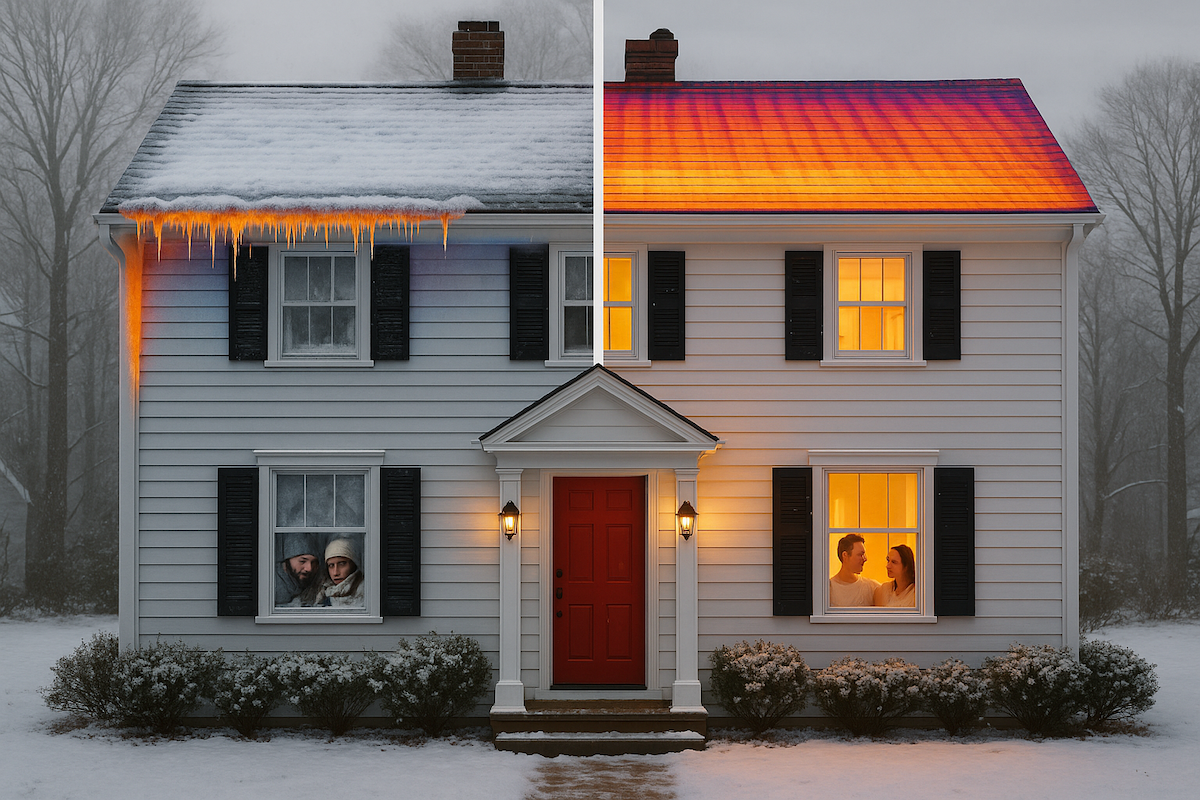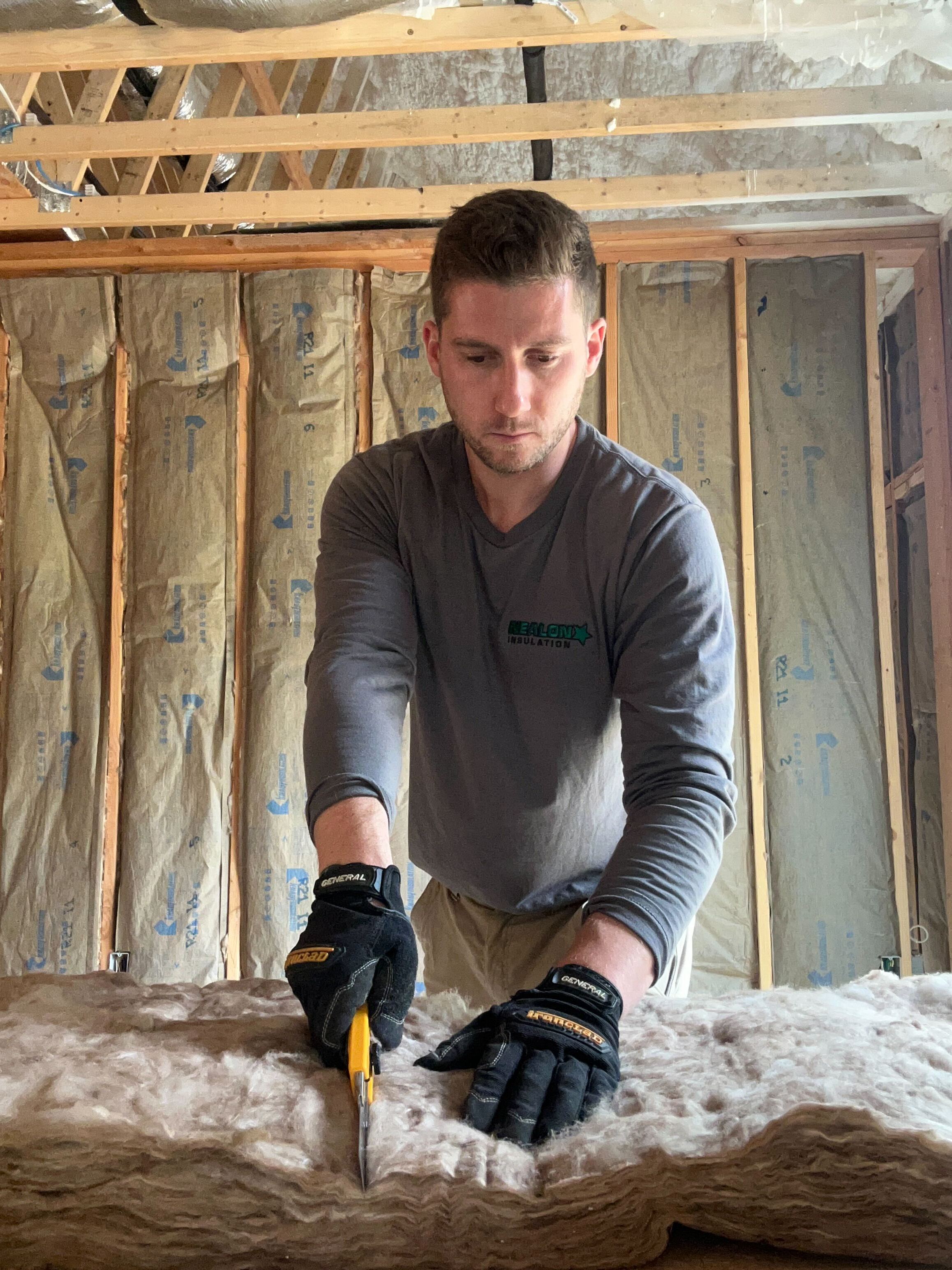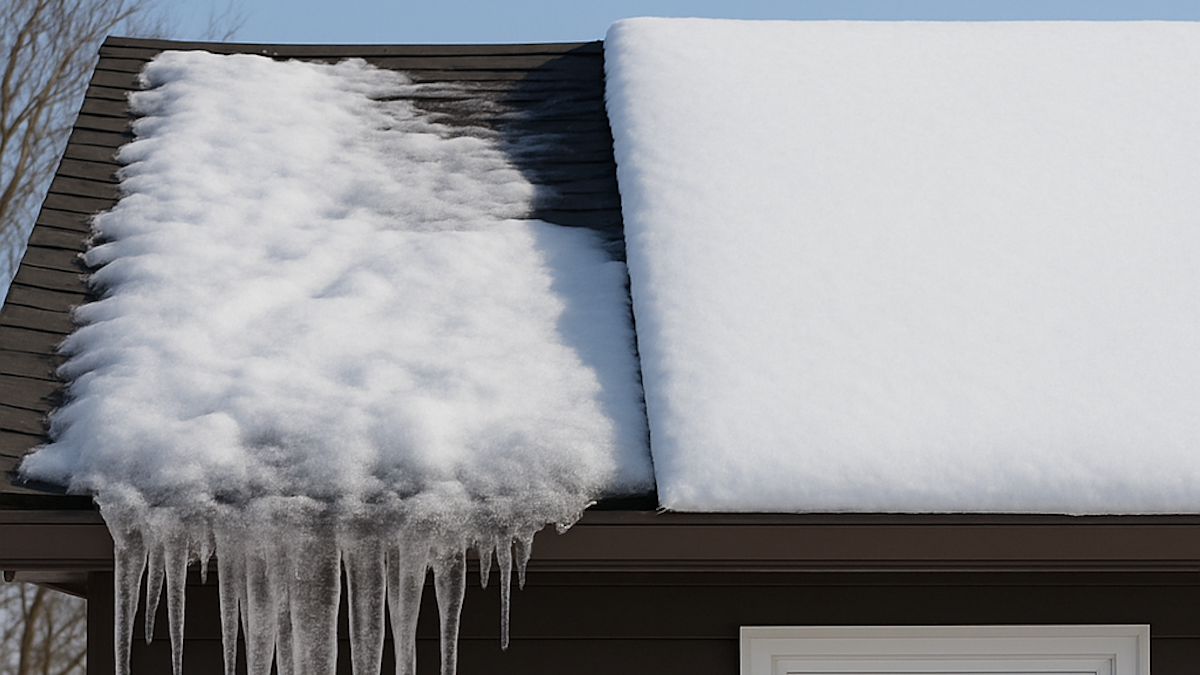What Does Insulation Do in a House?

Ever wonder why your feet are freezing in the living room while the upstairs feels like a sauna? Or why your energy bills are climbing even though you barely touch the thermostat?
Here’s a wild thought: the problem might not be your heating system—it might be your insulation (or lack of it).
Most people think of insulation as something stuffed in the attic and forgotten. But in reality, it’s one of the most important systems in your entire house—right up there with plumbing and electricity. And when it’s missing, damaged, or just plain old, your house starts bleeding money, energy, and comfort through the walls.
In this post, we’ll break down exactly what insulation does in a house, how it works, and why upgrading it might be the smartest thing you can do for your home—especially if you live in one of Connecticut’s drafty, older builds.
Let’s get into it.
What Does Insulation Actually Do in a House?
Here’s the short answer: insulation slows the transfer of heat. That’s it. That’s the magic.
But if you’ve ever wondered why your house feels like a walk-in freezer in January or a slow cooker in July, the real question is: how well is your insulation actually doing its job?
Think of insulation like a thermal blanket for your house—it helps keep warm air in during the winter and out during the summer. Without it, your home leaks energy through every crack and cavity. You end up paying to heat or cool the outdoors, which is great for your local squirrels… but not your wallet.
Insulation works by resisting the flow of heat, measured in something called R-value—the higher the number, the better the resistance. Whether it’s in your attic, walls, or crawl space, insulation helps regulate temperature, reduce strain on your HVAC system, and create a more livable, balanced home.
It’s not just about warmth—good insulation makes your house smarter, cleaner, and cheaper to run.
Why Insulation Is So Important
Insulation isn’t just about keeping your house warm in winter. It’s about control—of your comfort, your energy bills, and even your air quality.
Let’s break it down:
Comfort You Can Actually Feel
Without proper insulation, every season becomes a battle. Rooms get drafty. Temperatures swing wildly from floor to floor. Your HVAC works overtime just to try to keep up. With the right insulation in the right places? Your home stays balanced, quiet, and predictable year-round.
Lower Energy Bills (for Real)
When insulation slows the flow of heat, your heating and cooling systems don’t have to work as hard. That means less energy used and more money in your pocket. We’ve seen customers save hundreds a year just by tightening up their attic or wall cavities.
Cleaner, Healthier Indoor Air
Insulation helps block outdoor pollutants, allergens, and moisture from creeping inside. Combine it with proper air sealing, and you’ll improve indoor air quality while keeping musty smells, mold risk, and airborne irritants to a minimum.
Noise Reduction
A well-insulated house is a quieter house. Whether it’s traffic noise, barking dogs, or your kid’s drum set, insulation helps muffle sound between rooms and from outside.
Protects Against Moisture and Mold
Insulation slows down heat transfer, but it also plays a role in moisture control—especially in crawl spaces, rim joists, and attics. Less condensation means less risk of mold growth, wood rot, and those mystery smells nobody wants to deal with.
How Insulation Saves You Money
Let’s talk dollars and sense. Because while comfort is great, what most homeowners really want to know is:
Does insulation actually save me money?
Short answer: Yes. And more than you probably think. We have an ROI savings calculator to show it.
When your home is poorly insulated, it leaks heat like a cracked thermos. Your furnace or AC has to run longer and harder just to maintain a comfortable temperature—which means higher utility bills every month. Insulation slows that heat transfer, reducing the workload on your HVAC system and locking in the air you already paid to heat or cool.
Here’s what that looks like in real life:
- Upgrading attic insulation in an under-insulated home can cut heating and cooling costs by up to 15% (according to the U.S. Department of Energy).
- In older Connecticut homes—where insulation is often thin, outdated, or missing altogether—we’ve seen annual energy savings reach $500 or more, especially when paired with proper air sealing.
- And if you’re using oil, propane, or electric heat? The payback is even faster.
Bonus: Rebates and Tax Credits
As of 2025, federal energy efficiency tax credits can cover up to 30% of the cost of qualifying insulation upgrades. Utility companies in Connecticut also offer rebates for attic and wall insulation—so if you're doing it right, you’re not paying full price anyway.
Where Insulation Matters Most in a Home
Not all insulation is created equal—and not every part of your house needs it the same way. If you’re trying to get the biggest bang for your buck, focus on the areas that leak the most energy first.
1. Attic
If you only insulate one part of your house, make it the attic. Heat rises—and without a proper thermal barrier up top, all that warm air you paid for goes straight through the roof. Most older Connecticut homes are way under-insulated here. Blown-in cellulose or fiberglass is the go-to, and spray foam is great for sealing up tricky nooks.
2. Exterior Walls
This one’s sneaky. Many older homes, especially along the shoreline, were built with little to no insulation in the walls. If your living room feels like a meat locker in winter, that’s probably why. Dense-pack cellulose can be blown into wall cavities without ripping down drywall, and it makes a massive difference.
3. Crawl Spaces and Basements
Cold floors in the morning? Probably a leaky crawl space. Insulating rim joists, basement walls, and the underside of the floor helps keep your toes warm and moisture out. Spray foam and rigid foam boards are especially effective here.
4. Rim Joists
These are the horizontal sections where your home’s floor framing meets the foundation wall. Tiny area—huge impact. Left untreated, they’re basically wind tunnels. Closed-cell spray foam is the gold standard for sealing them up tight.
5. Garages (Attached or Finished)
If you’ve got a bedroom above the garage or use the space for more than just parking, insulating the ceiling and walls can seriously cut drafts and noise.
Types of Insulation and How They Work
Let’s clear something up—insulation isn’t one-size-fits-all. The best type for your home depends on where it’s going, how your house is built, and what kind of performance you’re after.
Blown-In Cellulose
Made from recycled newspaper and treated to resist pests and fire, cellulose is a dense, eco-friendly option that’s perfect for attics and wall cavities. It fills gaps completely, making it great for older homes with irregular framing.
- Best for: Attics, exterior walls
- Pros: Great air sealing, high R-value per inch, sustainable
- Watch out for: Settling over time if not dense-packed properly
Fiberglass (Batts or Blown-In)
Fiberglass is the pink stuff you’ve probably seen in big-box stores. It’s budget-friendly and works fine if it’s installed well—but that’s a big “if.” Gaps, compression, or sloppy work can cut its effectiveness in half.
- Best for: Attics, open wall bays, garages
- Pros: Widely available, low cost
- Cons: Loses performance if compressed or poorly installed
Spray Foam (Closed-Cell)
Spray foam is the air-sealing champion. It expands on contact, filling every crack and gap—perfect for stopping drafts cold. Closed-cell foam also adds structural strength and a moisture barrier.
- Best for: Rim joists, crawl spaces, hard-to-reach areas
- Pros: Excellent air sealing, high R-value, moisture resistant
- Cons: Higher cost, needs professional installation
Mineral Wool (Rockwool)
Mineral wool is like the tank of insulation—fire resistant, water resistant, sound-dampening, and easy to cut. It doesn’t settle or absorb moisture, which makes it ideal for places that get damp.
- Best for: Basement walls, soundproofing interior walls, fire-rated assemblies
- Pros: Fireproof, mold-resistant, great sound barrier
- Cons: Slightly pricier than fiberglass
Signs Your Home Might Need More Insulation
Not sure if your house needs insulation? You don’t have to be an energy auditor to spot the red flags. Most homes—especially ones built before the 1990s—are under-insulated by today’s standards.
Signs to look for:
- Rooms that are always too hot or too cold
- High utility bills despite conservative energy use
- Cold floors or drafty areas
- Ice dams forming on the roof in winter
- Musty smells, mold, or moisture buildup
- Rodents or pests nesting in the attic or walls
Bottom line? If your home feels uncomfortable, noisy, or expensive to heat—it’s probably time to take a hard look at your insulation.
Should You DIY or Call a Pro?
Insulation seems simple, but getting it right is trickier than it looks. Here’s how to decide:
DIY Might Work If:
- You’re insulating an open attic or unfinished garage
- You’re using batt insulation or renting a blower
- You know how to seal gaps and install without compression
Call a Pro If:
- You need dense-pack cellulose or spray foam
- You’re insulating walls or crawl spaces
- There’s old insulation to remove (especially if moldy or rodent-infested)
- You want maximum performance with air sealing included
A good contractor won’t just throw insulation into your house—they’ll assess where heat is escaping and tailor a solution that fits your home, not some cookie-cutter formula.
Common FAQ's about Insulation
Can insulation help with humidity in the house?
Insulation helps control humidity in the house by stabilizing surface temperatures and reducing condensation. When combined with air sealing, it limits moisture buildup—especially in basements and crawl spaces where damp conditions are common.
Is adding insulation worth it if I already have some?
Adding insulation is often worth it even if your home already has some. Many homes, especially in Connecticut, fall short of current standards. Topping off attic insulation or dense-packing wall cavities boosts comfort and efficiency without needing a full retrofit.
Can insulation be added without tearing down my walls?
Insulation can be added without tearing down walls by blowing dense-pack cellulose through small access holes. Contractors then patch the holes, making it a minimally invasive upgrade—ideal for older homes needing better energy performance without full renovation.
Does insulation help in the summer too, or just winter?
Insulation helps in both summer and winter. In summer, it blocks outdoor heat from entering your home, keeping interiors cooler and reducing strain on your air conditioner. It’s just as critical for preventing heat gain as it is for retaining warmth in winter.
Can I insulate just one room or area of the house?
You can insulate a single room or area, but results may be limited if other parts of the home still leak energy. Targeted upgrades—like attic insulation above a hot room or sealing rim joists—can still improve comfort and efficiency without needing a full-home project.
The Bottom Line: Insulation That Works, Comfort You Can Feel
Insulation isn’t something you think about every day—but you feel it every day. It’s the quiet workhorse behind a comfortable, efficient, healthy home. And when it’s missing, you pay for it—in higher energy bills, drafty rooms, cold floors, and noisy walls.
Whether you’re living in a hundred-year-old shoreline Cape or a newer build with mystery hot spots, the fix usually starts with a proper insulation assessment. The right materials, installed the right way, can make a night-and-day difference—not just in how your house feels, but in what it costs to live there.
So if your home’s been feeling a little off, don’t just turn up the heat. Fix the root of the problem.
Related Articles
Let's Work Together
Ready to transform your home into an energy-efficient haven? Schedule your free energy assessment today and experience the Nealon difference for yourself.



